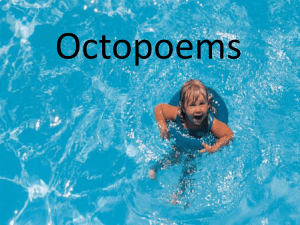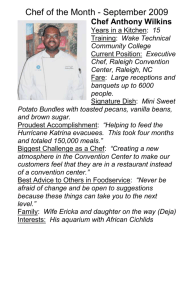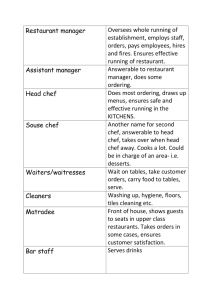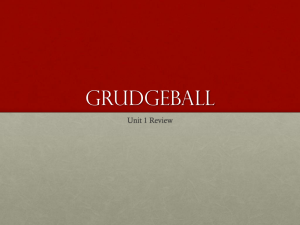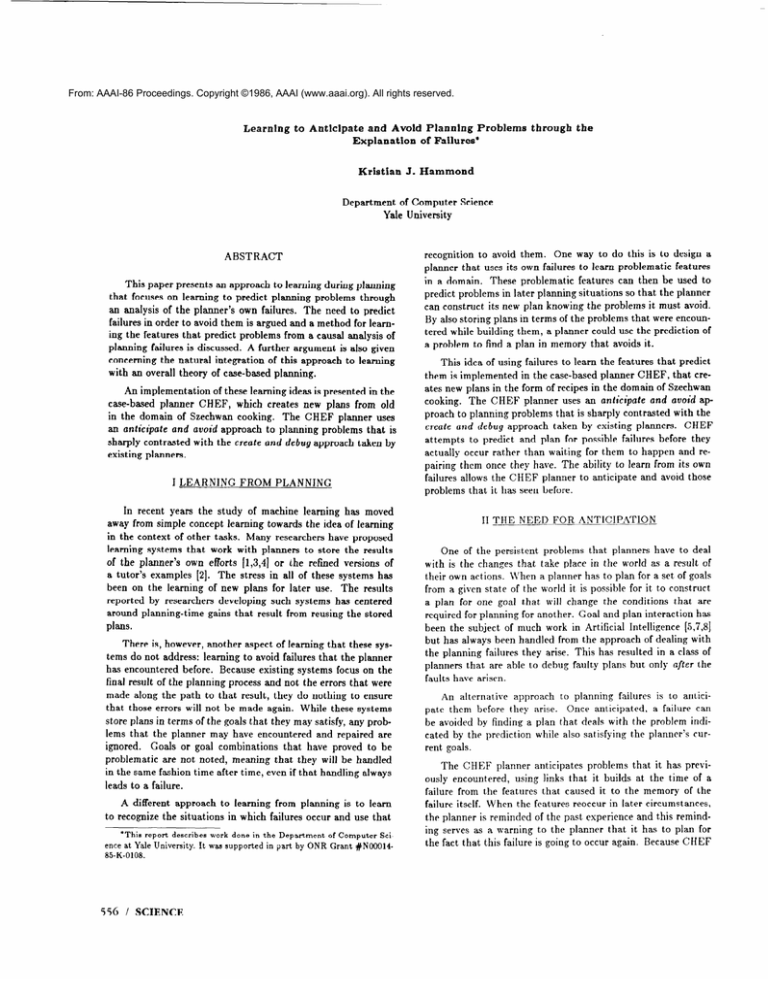
From: AAAI-86 Proceedings. Copyright ©1986, AAAI (www.aaai.org). All rights reserved.
Learning
to Anticipate
and Avoid Planning Problems
Explanation
of Failures*
Kristian
Department
presents
an approach
the
J. Hammond
of Computer
Yale University
Science
One way to do this is to design a
recognition
to avoid them.
planner that uses its own failures to learn problematic
features
ABSTRACT
This paper
through
to learning
during
in a domain.
planning
that focuses on learning
to predict planning
problems
through
an analysis of the planner’s
own failures.
The need to predict
predict
These
problems
can construct
problematic
features
in later planning
can
situations
its new plan knowing
then
be used
so that
the problems
to
the planner
it must
avoid.
failures in order to avoid them is argued and a method for leaming the features that predict problems
from a causal analysis of
planning
failures is discussed.
A further argument
is also given
concerning
the natural
integration
of this approach
to learning
with an overall theory of case-based
planning.
By also storing plans in terms of the problems that were encountered while building them, a planner could use the prediction
of
a problem to find a plan in memory that avoids it.
An implementation
of these learning ideas is presented
in the
case-based
planner
CHEF,
which creates new plans from old
ates new plans in the form of recipes in the domain of Szechwan
cooking.
The CHEF planner
uses an anticipate
and avoid ap-
in the domain of Szechwan
cooking.
The CHEF planner
uses
an anticipafe
and avoid approach
to planning
problems
that is
proach
create
sharply
existing
with the create and debug approach
contrasted
planners.
by
FROM
to planning
and debug
attempts
of other
tasks.
Many
problems
approach
to predict
learning
has moved
the idea of learning
researchers
failures
to learn
in the case-based
the features
planner
that
CHEF,
predict
that
cre-
that is sharply contrasted
with the
taken by existing planners.
CHEF
and plan
for possible
failures
before
they
occur rabher than waiting for t,hem to happen
and rethem once they have. The ability to learn from its own
failures allows
problems that
PLANNING
In recent years the study of machine
away from simple concept learning towards
idea of using
is implemented
actually
pairing
I LEARNING
in the context
taken
This
them
the CHEF planner
it has seen before.
II THE
NEED
to anticipate
FOR
and avoid
those
ANTICIPATION
have proposed
learning
systems that work with planners
to store the results
of the planner’s
own efforts [1,3,4] or ihe refined versions of
a tutor’s examples [2]. The stress in all of these systems has
One of the persistent
problems
that planners
have to deal
with is the changes
that take place in the world as a result of
their own actions.
11’hen a planner has to plan for a set of goals
been
from a given state
on the
learning
of new
plans
for later
use.
The
results
reported
by researchers
developing
such systems
has centered
around planning-time
gains that result from reusing the stored
plans.
There is, however, another aspect of learning that these systems do not address:
learning to avoid failures that the planner
has encountered
before.
Because existing systems focus on the
final result of the planning
process and not the errors that were
made along the path to that result, they
that those errors will not be made again.
store plans
in terms
of the goals that
lems that
the planner
ignored.
Goals
may have
or goal
do nothing
to ensure
While these systems
they may satisfy,
encountered
combinations
that
any prob-
and repaired
have
proved
are
to be
problematic
are not noted, meaning
that they will be handled
in the same fashion time after time, even if that handling
always
leads to a failure.
A different
to recognize
approach
the situations
to learning
in which
from
planning
failures
occur
is to learn
and use that
/ SCIENCE
for one
of the world
goal
t,hat
it is possible
will change
for it to const.ruct
the conditions
that
are
required for planning
for another.
Goal and plan interaction
has
been the subject of much work in Artificial
Intelligence
[5,7,8]
but has always been handled
from the approach
of dealing with
the planning
failures they arise. This has resulted in a class of
planners
faults
t,hat
are able to debug
faulty
plans
but only
after the
have arisen.
An alternative
approach
to planning
failures
is to anticiOnce anticipated,
a failure can
pate them before they arise.
be avoided by finding a plan that deals with the problem indicated by the prediction
while also satisfying
the planner’s
current goals.
The
ously
failure
*This report describes work done in the Department of Computer Science at Yale University. It was supported in part by ONR Grant #N0001485-K-0108.
556
a plan
CHEF
encountered,
from
planner
using
t,he features
anticipates
links
that
problems
that
caused
it builds
that
it has previ-
at the time
it to the memory
of a
of the
failure itself. When the features reoccur in later circumstances,
the planner is reminded
of the past experience
and this reminding serves as a warning
the fact that this failure
to the planner
that it has to plan for
is going to occur again. Because CHEF
also stores
the repaired
plans
that
were built
in response
to past
failures, indexed by the fact that they solve the problem corresponding
to the failure, CHEF is able to use the prediction
of
the problem
to find a plan
that
avoids
it.
For example,
in trying
to create a plan for a strawberry
souffl6, CHEF encounters
problems
with the liquid added by
the addition
of chopped
strawberries
to the soufflC batter.
added
liquid
liquid causes
and leavening
an imbalance
in the relationship
in the recipe.
This alters the
which
was required
for the
soufflC to rise,
which
This
results
circumstances
at a later date. So CHEF does two things. First
it stores the new plan in memory,
indexed by the fact that it
to deal
with
the problem
of added
liquid
in a souffld
recipe. But indexing a plan by the fact that is solves a problem
is of no use unless the problem
is anticipated.
So CHEF also
links from
itself.
the features
(added
With
fruit
these
in the situation
or extra
links
liquid)
in place,
that
to a memory
it is later
In dealing
with a later
situation,
in which
the
of the failure
able
occurrence
of the failure from the reoccurrence
that participated
in causing it earlier.
caused
to infer
the
of the features
CHEF
is planning
for a soufflC with the liqueur kirsch, it is reminded
of the past
situation
and
failure.
This tells CHEF that it is in a problem
it adds the goal to avoid the problem
to the list of goals used
to search for an initial plan. It then finds the strawberry
soufflk
recipe, with
kirsch rather
the added egg white, and
than strawberries.
Without
modifies it to include
the anticipation
of the
failure, CHEF would have used a more basic vanilla soufflk recipe
and would have built a plan with the same flaw as in the failed
By anticipating
the failure, CHEF is
strawberry
soufflC plan.
able to find a plan
that
avoids
it.
III AN OVERVIEW
CHEF’s
ingredients
that
past
input
and types
of dishes
and its output
tastes,
textures,
is a single recipe
satisfies a!! of its goals.
Its basic algorithm
is to find a
plan that satisfies as many of the most. important
goals as
possible
well.
and then
modify
that
plan
to sat,isfy
the other
goals as
Before searching
for a plan to modify, CHEF examines
the
goals in its input and predicts any failures that might rise out the
interactions
between
the plans
for satisfying
them.
If a failure
is predicted,
CHEF adds a goal to avoid the failure to its list
of goals to satisfy and this new goal is also used to search for
a plan.
For example,
snow peas
if it predicts
will lead to soggy
that
stir frying
snow peas because
chicken
the chicken
with
will
sweat liquid the pan, it searches for a stir fry plan that avoids the
problem of vegetables
getting soggy when cooked with meats. In
doing so, it finds a past plan for beef and broccoli
this problem by stir frying the vegetable
and meat
The important
planner has been
avoid problems
before
similarity
between
the current
situation
planning
t.hey actually
IV LEARNING
CHEF’s
is done.
This means
arise.
FROM
FAILURE
that solves
separately.
and the
one for which the past plan was built is that the same problem
rises out of the interaction
between the planner’s goals, although
the goals themselves
are different.
CHEF
buiids
version
are checked
a plan,
it runs
a simulation
of the real world.
against,
the goals
The results
that
CIIEF
of it that
is
of tliis simulation
expects
the plan
to
satisfy. These goals include the goals CHEF is given by the user
as we!! as those it understands
should be satisfied by an instance
of the type of plan it hau built. CHEF understands
that its plan
for strawberry
sot&k should include the strawberries
requested
by the user and also understands
that it should, like a!! soufflE”s,
be baked
and fluffy.
If the goals that
the results
the plan is designed
of the simulation,
CHEF
to satisfy
considers
are not met in
t,he plan
a failure
altering
the
faulty
plan.
understandin,
u of the world that was used to create
It is important
to note here that “failure8
means
the
the
failure
of a plan to achieve
and begins
the task
of fixing
the faulty
its goals,
plan
and
not a failure
of the planner
to create a plan. CHEF builds up a causal explanation
of why
the failure occurred
and uses that description
to access a set
of repair
strategies.
from the failure
a set of causal
are accessed,
actual
This explanation
to the initial
Once
changes
tries to implement
to the plan.
most likely to succeed
In the example
the results
t.he explanation
CHEF
is built
st,eps or states
rules the describe
circumstances.
plains
liquid
OF CHEF
is a set of goals for different
before any other
of a problem car be used to find a plan in
it while also satisfying
the goals that the
and then
given, allowing CHEF t.o anticipate
Once
the failure later on, it, has to change more than the current plan.
It also has to change the way in which it will plan for similar
problem
problems
that the anticipation
memory that avoids
in a
CHEF is able to recover from this failure by adding more
egg white to the recipe. But because it does not want to repeat
builds
predict
between
condition
fallen souffle.
is a plan
CHEF indexes its plans in memory by both the goals that
they satisfy and the the problems that they avoid. It also tries to
by back
that
caused
of actions
is built
of the failed
introducing
strawberry
it, using
in different
and the strategies
the different
It makes the one change
without
chaining
strategies
as
which seems
any new problems.
souffl6,
CHEF
ex-
between the
the fallen SOUWC as a result of an imbalance
and leavening
in the recipe.
This imbalance
is traced
back to the strawberries
that were added in order to meet the
user’s goals. In terms of CHEF’s vocabulary,
this problem
is a
case of SIDE-EFFECT:DISABLED-CONDITION:BAL,4NCE
because
balance
a side-effect
of adding the strawberries
has disabled a
condition
that is required for the success of the BAKE
This explanation
is used to find a planning
step in the plan.
TOP, one of a set, of structures
that correspond
to different planning problems,
and this TOP suggests the actual strategies that
are used to repair the plan. These TOPS are planning versions of
the Thematic
Organization
Packets suggested
by Roger Schank
for use in understanding
[6].
memories
around
goal and plan
Searching
for
complex
TOP using
They
following
are
designed
to organize
interactions.
explanation:
Failure = It is not the case that: The batter is risen.
Initial
plan = Bake the batter for twenty five minutes.
= There is an imbalance
Condition enabling failure
between the whipped stuff and the thin liquid.
Cause of condition
= Pulp the strawberry.
The goals enabled by the condition
= NIL
The goals that the step causing the condition
enables The dish nov tastes
like berries.
LEARNING
I 557
Found TOP TOP3 -> SIDE-EFFECT:DISABLED-CONDITION:BALANCE
TOP -> SIDE-EFFECT:DISABLED-CONDITION:BALANCE
has 6
strategies
associated
with it:
ALTER-PLAN:SIDE-EFFECT
RECOVER
ALTER-PLAN:PREC~lDIfION
ADJUNCT-PLAN
ADJUST-BALANCE
: UP
Each
change
of the different
in the causal
sbrategies
chain
that
under
leads
the TOP
suggests
to the current
a
to anticipate
the problem
the plan that handles it.
ALTER-PLAN:SIDE-EFFECT
to achieve the initial goal that
suggests
using an action
does not have the offending
liquid.
The alteration
CHEF finds is to use strawberry
preserves rather than crushed strawberries.
ALTER-PLAN:PRECONDITION
suggests
finding
a al-
ternative
to the blocked st,ep that does not require the
conditions
that the first part of t,he plan has violated.
This
would mean finding a step to make the batter rise that does
not reqluire the balance between the liquid and leavening.
CHEF can find no action that will do this.
l
RECOVER
suggests
that
the side-effect
caused
putting
a step
between
and the step
that will remove the offending state.
step that will remove the liquid that
the
action
it interferes
with
This means finding a
results from chopping
the strawberries
before the batter
is baked.
that draining
the strawberries
will do this.
and thus find
solves
a certain
plan but
problem
is one of the
is not the only one.
Other
important
features
features
include
input goals and the goals inferred by CHEF
the dish requested
and the ingredients
used.
that
that
it
it
of a
the initial
from the nature
of
failure.
side-effect.
In this situation
this would mean finding a way
to add the taste of strawberries
that does not add extra
l
circumstances
CHEF indexes the new plan under all of the goals
satisfies as well aa the problems
that it solves. The fact
STRAWBERRY-SOUFFLE
under the features:
Indexing
l
in similar
CHEF
finds
Goals requested
and inferred:
Include strawberry
in the dish.
Make a souffle.
The batter is now risen.
The dish now tastes
like berries.
The dish nov tastes
sweet.
Problems avoided:
The plan avoids the failure
‘It is not the case that: The batter
caused by conditions:
“Chopping fruits
produces liquid.”
“Without a balance between liquids
the batter will fall.”
The repaired
plan
is only part
of what
is
now risen.’
and leavening
the planner
learns.
It
also learns to recognize the situations
in which the plan is useful.
It does this by stepping
through
the causal explanation
it has
on the rules that were used in
built and using t5he constraints
connecting
actions to effects and states to the results that they
enable.
ADJUNCT-PLAN
suggests adding a new step to run concurrent with the step that has the violated condition
that
l
will allow it to satisfy
the goal even in the presence
of the
violation.
In this example this means Finding a step that
will allow baking the existing batter to have the desired
effect. CHEF finds t&hat adding flour to the batter will do
this.
ADJUST-BALANCE:UP
l
suggests
side of the imbalanced
adjusting
by adding
the
down-
more of what
out which
ends
has
the
up
using
Once
the
more
of the egg-white
suggestion
made
to add more egg white because
least
possibility
This is determined
different
adding
changes
using
of creating
used
as
by ADJUST-
this is the change
any
unwanted
a set of heuristics
that
side-
evaluate
at the level of the domain.
this change
is made
CHEF
is in a powerful
but
also
the
more
general
versions
of them
staying
within
In the
that
this
problem
/ SCIENCE
and
it can build
and its memory
the links
of the failure
between
that
might
features
will allow it
cause
the confines
of the rules t,hat explain
STRAWBERRY-SOUFFLE
the liquid was a product
situation,
of the chopping
the failure.
one
rule
ex-
of the straw-
in the future would
as predictive
of it
and be reminded
of t&he failure whenever
it is asked to make a
strawberry
soufflk. But the rule that explains the added liquid
as a side-effect
of chopping
the strawberries
does not require
that the the object of t,he step be strawberries.
It explains that
chopping
any fruit will produce this side-effect.
So, instead of
marking
STRAWBERRY
as predictive
of the problem,
CHEF
can mark FRUIT as predict,ive.
Building
demons to anticipate
Building
between
demon:
rules:
Indexing
by test:
demon: DEMON2under item:
Is the item a FRUIT.
date. This means it can perform both of the tasks it needs to do
in order to avoid this failure in the future: it can index the new
plan in memory by the fact that it is a special plan that deals
in the situation
that
it again.
It gets these more general features by generaliait~g
to
the level of the rules. This means generalizing
an object in an
explanation
up to the highest level of description
possible, while
position.
It has a working plan for a set of goals and it knows that this
plan avoids a particular
problem.
It also has an explanation
of
why the problem
occurred
in the first pface and can use this
explanation
to figure out which features will predict it at a later
in a
features that will be predictive
of the failure. Here CHEF wants
to know not. only the exact features
that caused the problem
berries. A simple way to predict this failure
be for the planner to mark STRAWBERRY
means
features
and uses it again to find the
ship. This
leavening.
effects.
558
to point
for a failure
plains
BALANCE:UP
with
uses the explanation
are responsible
there is less of. In this example,
this means adjusting
the
down-side of the imbalanced
liquid and leavening relation-
CHEF
that
relationship
CHEF
situation
failure.
DEMON2to anticipate
interaction
“Chopping fruits
produces liquid.”
“Without a balance between liquids
and leavening
the batter will fall.”
FRUIT
Indexing
demon: DEMON2under style:
as predictive
of a problem by following the causal chain defined
by the explanation
from the first causes of the problem to the
SOUFFLE
ones more immediate
to the actual failure.
Third, it is able to
use the rules that were used to explain the situation
to control
the level of generalization
of the features
marked as predictive
of the problem.
The explanation
gives CHEF the information
it
Goal to be activated
= Avoid failure
of type
SIDE-EFFECT:DISABLED-COBDITION:BALINCE
by the failure
‘The batter
is now flat’
exemplified
in recipe STRAWBERRY-SIIUFFLE.
needs to learn from a single instance
A causal
explanation
of why
a failure
is a chain of
occurs
events and states in which each link is a potential
predictor
the failure occurring
again. The goal to include strawberries
the out.ermost
link in this chain
while
the liquid
they
States
marked
the failure
that
at a later
are intermediate
as predictive
links
in causing
along with
a failure
the initial
activates
the memory
Building
between
demon: DEJ4ON3to anticipate
interaction
“Liquids make things wet.”
rules:
Without
a balance
betlreen liquids
and leavening
the batter
vi11 fall.”
Make
when
Indexing
by test:
demon:
Is the
are
Include
Make
SPICE
SOUFFLE
it is liquid.
Indexing
demon: DEMON3under style:
CHEF
problems
goals in a new input
is reminded
of.
SOUFFLE
is able to learn
at a later
date.
is spread
the features
features
infers
that
the problem
of
is going
to
arise as well.
These
links
are arranged
so t,hat all features
responsible
for
a failure have to be present for it to be predict,ed. But different
combinations
of features may all predict the same failure. Figure
1 shows a simplified version of the activation
links leading to a
failure. When all links leading into the memory of a failure are
activated
the memory is also activated.
The test for the texture
of the goal to include any spice cont,rols the flow of activation
through
that link.
By using the explanation
tant features in the situation
of the failure to identify the imporCHEF gains in three ways. First it
is able to learn from a single instance
herent
to the repetition
ing systems.
Second,
of examples
and avoid the problems
required
it is able to identify
by inductive
a range
in-
learn-
of situations
to any
goal to include
CHEF’s own goals to memories of the failure itself. When these
surface fcaturrs
arise in later situations,
the memory of t.he failand CHEF
to the memory
A NEW
of the fallen
soufflC
PROBLEM
and attending
to any past
failures
t#hat it
After solving the problem of the strawberry
souffl15, CHEF is
asked to make a soufllk with the liqueur kirsch. Before planning
for these new goals, CHEF activates
them and this activation
This knowl-
edge is in the form of the links going from the surface
ure is activated
leading
Once CHEF has learned the features that predict a problem,
it is able to anticipate
the problem from those features.
It does
this by sending out activations
along all of the links from the
Goal to be activated
= Avoid failure
of type
SIDE-EFFECT:DISARLED-CONDITION:BALANCE
exemplified
by the failure
‘The batter
is now flat’
in recipe STRAWBERRY-SOUFFLE.
this failure,
1: Links
V PREDICTING
DF.MON3under item: SPICE
IEXTURE of item LIDUID.
similar
possible.
SOUFFLE
Figure
will predict
this problem
of situations
goals
STRAW BERRY-SOUFFLE,
t%hegoal to include any liquid spice
is linked to the memory of the failure.
This is implemented
by
placing a test on SPICE that checks the texture
and partially
By examining
and anticipate
range
produce
that started the chain of events leading to it. CHEF generalizes
these states up to the level of the rules that explain the failure
and links them to a token representing
the failure. Because the
presence of liquid is implicated
in causing the failure with the
that
and widest
date.
of the problem
of the failure
general
of
is
when chopped
is a more direct cause of the failure.
Because
the liquid from the strawberries
is just as much a cause of the
problem as the goals t,o include the strawberries,
it can also be
used to predict
in the most
which
in turn
fallen soufflC.
failures
kirsch
sends
that
they
activates
an activation
Because
kirsch
predict.
the goal
In this
to include
towards
is a liquid
case,
any
the memory
and thus passes
the
spice,
of t,he
the test
along this line of activation,
the signal reaches the memory of
t.he failure.
At the same time, the goal to make a soufflC sends
off an act.ivation
leading
CHEF
current
signal
to the same
to the memory
responds by adding
goal list.
are
and activating
When
it is also
a goal to avoid
Searching for plan that satisfies
Include kirsch in the dish.
Make a souffle.
Collecting
memory.
activated
both
links
activated
and
this problem
into its
LEARNING
/ 559
-
tests.
Fired:
Is the dish
STYLE-SOUFFLE.
Fired:
Is the item a SPICE.
Is the TEXTUREof item LIQUID.
Kirsch + Souffle
= Failure
“Liquids make things wet.”
Vithont
a balance between liquids and leavening
batter rill
fall.”
Reminded of STRAWBERRY-SOUFFLE.
Fired demon: DEMON3
Adding goal: Avoid failure
of type
SIDE-EFFECf:DISABLED-CONDIIION:BALANCEexemplified
the failure
‘The batter is now flat’ in recipe
STRAYBERRY-SOUFFLE.
the
Because
this recipe has already
by
CHEF is able to predict this problem,
even though the surface features of its current situation do not match those of the
past situation,
because
were made
the links formed
on the basis
the failure actually
occurred.
the planner was able to learn
to the past
understanding
of why
By using this causal explanation,
the true extent of the problem and
anticipate
it in markedly
different
which it originally
occurred.
VI USING
in response
of a causal
THE
circumstances
than
kirsch
rather
VII C?QNCLUSIONz
Planning
failure
to the problems
been adapted
of added liquid, it ca.n easily be modified to include
than strawberries
and runs without failure.
those
in
failures
can
tell a planner
where
its own reason-
ing has gone wrong. They can provide information
about what
ieatures will tend to lead to a failure and when to anticipate
them in later planning. A planner that learns from one failure
to anticipate later ones and uses that anticipation
plans that deal with it is able to avoid those failures
already
to find the
that it has
encounterecl.
CHEF
learns from its own errors and thus avoids them in
the later planning.
Learning from a dozen examples at the same
level of complcsity
as the one discussed
here, it identifies
the
problematic features of its domain and creates the plans to deal
PREDICTION
with them.
Once the prediction
of a failure is made, the planner searches
for an existing plan that satisfies as many of its current goals
as possible while avoiding
the predicted
problem.
Plans that
By using a causal explanation
of why a failure has occurred
to identify the features will predict it in the future CHEF is able
are modified
most
in response
to failures
are indexed
by the fact that
they deal with those failures, so the prediction of a particular
problem can be used to index to a plan that solves it.
to learn from a single
general
soufflk,
would
have
been used
because
it has more
surface
soufflC and the standard
have also led to a failure
modifications
that CHEF
in this instance.
The fact
uses would
that CHEF
recognizes
that its present situation
is analogous
to a past one
in which a problem
has occurred
allows it to find a past plan
that
tures
avoids
that
in common
problem
with
even though
the present
it has fewer surface
situation
than
another
in memory.
Searching for plan that satisfies
Make a souffle.
Avoid failure
of type
SIDE-EFFECT:DISABLED-CONDITION:BALANCE.
Include kirsch in the dish.
Driving down on: Make a souffle.
Succeeded Driving down on: Avoid failure
of type
SIDE-EFFECT:DISABLED-CONDITION:BALANCE.
Succeeded Driving down on: Include kirsch in the dish.
Failed - Using recipe
from current
level.
Found recipe -> REC12 STRAWBERRY-SOUFFLE
Recipe exactly satisfies
goals ->
Make a souffle.
Avoid failure
of type
SIDE-EFFECT:DISABLED-CLlNDITION:BALANCE.
Recipe must be altered to match ->
Include kirsch
in the dish.
560
/ SCIENCE
CHEF
avoid the mistakes
feaplan
of situations
possible.
in the
And once
is able to improve itself by learning to
that
ot.her p!anners
are unable
to anticipate.
REFERENCES
fea-
tures in common
with the goals that CHEF has in hand. But
this plan was used in the past to construct
the failed strawberry
the problem
and anticipate
range
the problem is anticipated,
it can be avoided by making use of
a plan designed to deal with it. Unlike planners that only store
their successes,
In planning
for the kirsch souffl& the prediction
of the failure allows CHEF to access the existing strawberry
soufflk plan.
Without
the prediction,
another
plan, a recipe for a vanilla
instance
and widest
Carbonrll,
J., Derivational
Analogy and its Role in Problem
Solving, Proceedings of the National Conference on Artificial
Intelligence,
RAAI,
Washington,
DC, August
1983.
DeJong,
G ., AcrrJiring
Schemata
Through
Understanding
Proceedings of the Eight Internaand Generalizing
Plans.,
IJCAI,
tional Joint Conference on Artificial Intelligence,
Karlsrhue,
Germany,
S, Selectively
Minton,
Solving,
1983a.
August
Proceeding,?
<?eneralizing
01 the Ninth
Plans
for
National
Problem-
Conference
on
AAAI, Los Angeles, CA, August 1985,
.4rfdficial Intelligence,
pp. 313-315.
Mitchell, T., Learning and Problem Solving, Proceedings
the Eighth International
Iiarlsrhue,
ligence,
Thought
Award
Sacerdoti,
Report
on Artificial
Conference
Germany, August 1983.
01
Intel-
Computers
and
Lecture.
F,., A structure
109, SRI I?rtIficial
R.. Dynamic
Schank,
puters
Joint
for plans and behavior, Technical
Inteiligence
memory:
and people, Cambridge
Center,
1975.
A theory of learning
University
Press,
in com-
1982.
Intelligence
Series,
Volume 1: A
G ., Artificial
model of skill acquisition, American Elsevier, New
York, 1975.
Sussman,
computer
Wilensky,
Reading,
El., Pllrnning
Mass, 1983.
and
Cinderstanding,
Addison-Wesley,


